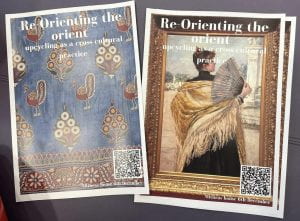Annie Wright, Grace Dowle, Megan Glass, Avery Chamberlain and Eden Cronin have curated an exhibition reflecting on the connection between objects associated with the idea of ‘the Orient’ and the social construction of cultural difference within British society in their second-year project for the BA History of Art and Design module ‘Understanding Exhibitions and Creating Displays’.
Reorienting the Orient: Upcycling as a Cross Cultural Practice, Mithras House, 6th Dec 2023
Reorienting the Orient is an exhibition that aims to explore the narratives and aims of cross-cultural consumption and the repurposing of cultural garments for alternative uses in the west. Ideas surrounding where these garments were intended to be worn are contrasted between systems of international export and local trading, which allows for an interesting comparison in the usage of oriental clothing in Britain.
Orientalism, a term coined by Edward W. Said, describes the western construction of ‘the Orient’ as a place of mysticism and exoticism and reflects Britain’s imperial relations with Asia. Britain’s connections to the Orient have influenced popular fashion trends in many ways through the years. Reorienting the Orient documents multiple examples of the dissemination of imported Oriental goods into British society, whilst also providing context behind specific examples.
The exhibition features two main pieces, selected from the Dress History Teaching Collection. The first, a skirt most likely handcrafted by the Rabari, a nomadic tribe indigenous to the Kutch district of Northern India. Despite initially being thought to be from the Rajasthan state of India, research suggests the bright embroidered motifs of peacocks and mango trees to be that of Rabari craft. This skirt would have been created for local consumption within the Kutch district, but was brought to Brighton by John Gillow amidst the British fascination with Indian culture during the 1960’s.
Reorienting the Orient: Upcycling as a Cross Cultural Practice, Mithras House, 6th Dec 2023
The second garment from the same collection is a Cantonese shawl, dating anywhere from the late 19th to early 20th century. Also being known as ‘Manila Shawls’ and ‘Manton de Manila’, these fabrics were most often made of silk and featured the Yue embroidery that is native to the Canton region. Patterns on these shawls often include scenes from nature and mythical creatures. This specific example features embroidered motifs of foliage on cream silk, with a border of fringe encasing the design. In contrast to the Rabari skirt, these Cantonese shawls would have been made specifically for western use. The consumption of these garments in Europe would ultimately lead to the commissioning of western cultural emblems to be embroidered on them, and the chartering of trade companies designed to import these products to various European nations.
Reorienting the Orient: Upcycling as a Cross Cultural Practice, Mithras House, 6th Dec 2023
Although both of these pieces show the significance of orientalist clothing in Britain in both the 19th and 20th centuries, ‘Reorienting the Orient’ also displays evidence of orientalism as an ongoing practice. This is shown through the exhibiting of two recent examples, purchased by the curators locally, in the Brighton lanes. Displayed on a mannequin alongside the Rabari skirt is a long sleeve cropped blouse in a rich maroon colour. The pattern featured on the garment shows clear inspiration from South Asian clothing and shows how cultural items from the Orient may have been understood and worn in a westernised context. Alongside the Cantonese shawl, a small toiletry case is displayed, which features designs and motifs that are heavily east-Asian inspired. Despite a lack of information on this piece, the purpose can be assumed to be that of western consumption, with copies of this very product being found on selling sites such as eBay.
Throughout Reorienting the Orient, the idea of a difference in production and consumption remains constant, with comparisons between the intended purposes, trade routes and the adopting of the exhibited garments into western society.
The exhibition, curated by Annie Wright, Grace Dowle, Megan Glass, Avery Chamberlain and Eden Cronin, is now available for viewing on the second floor of Mithras House (top of the Hellerup stairs).


